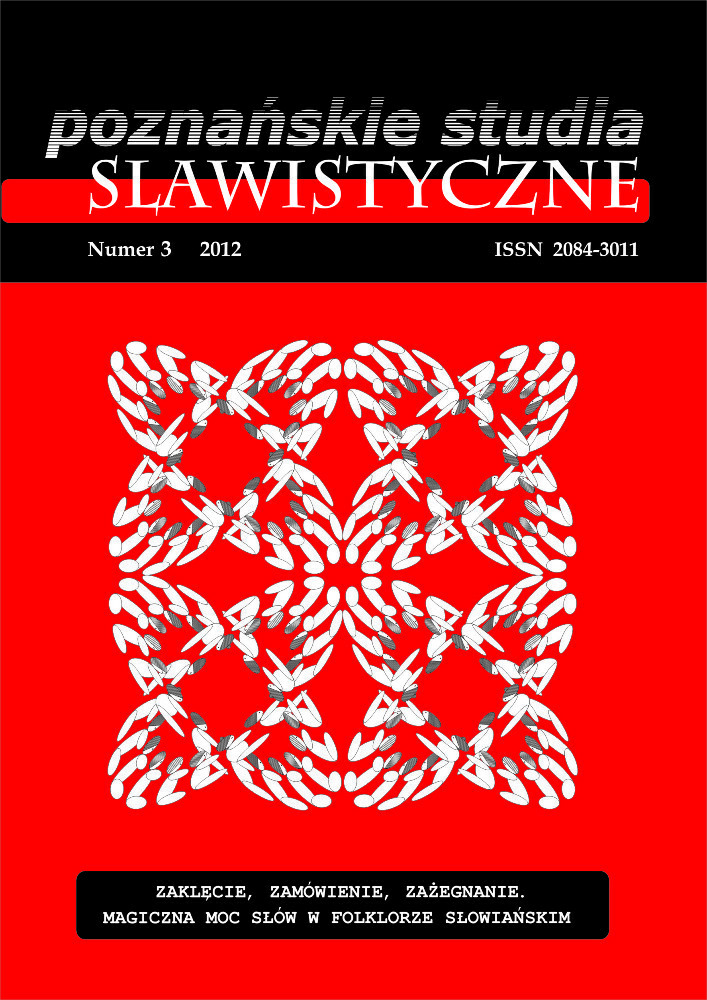Abstrakt
The line between Orthodox Christianity and pagan/folk customs and beliefs in the fifteenth century Slavia Orthodoxa was not precisely drawn. The population called upon spiritual forces of all kinds, to heal illnesses and injuries. Though the official position of the Orthodox Christian Church was to condemn and suppress these pre-Christian beliefs, certain elements such as magical words were included in Church-sanctioned texts. The fifteenth-century South Slavic trebnik (Hilandar HM.SMS.378) is one example of such a text. In addition to its canonical material, it contains a healing rite for a snakebite, which blends Orthodox Christian elements and pre-Christian ones, utilizing magical words. In this article, I examine Hilandar HM.SMS.378 – the magical words, the symbolism, and the cultural background – and compare it with two similar rites from a medieval South Slavic lječebnik (‘book of healing’) transcribed by V. Jagićin 1878. I also discuss the possibility that the three rites share a common origin.
Bibliografia
„Definitions for Medieval Christian Liturgy: Kyrie eleison”, http://www.yale.edu/adhoc/research_resources/liturgy/d_kyrie.html [date of access: 3.3.2006].
Apocrypha and Pseudepigrapha of the Old Testament, ed. R. Charles, vol. II, Berkeley, California 2004.
Barford P., The Early Slavs: Culture and Society in Early Medieval Eastern Europe, New York 2001.
Benson M., Šljivić-Šimšić B., Serbocroatian-English Dictionary, Philadelphia 1971.
Brewster P., Foundation Sacrifice Motif in Legend, Folksong, Game, and Dance, in: Walled-Up Wife: a Casebook, ed. M. Dundes, Wisconsin 1996.
Douglas M., Purity and Danger: an Analysis of the Concepts of Pollution and Taboo, London 1966.
Husband W., „Godless Communists”. Atheism and Society in Soviet Russia, 1917–1932, Illinois 2000.
Jagić V., Opisi i izvodi iz nekoliko južnoslovinskih rukopisa, „Starine” no. 10, 1878.
Levin E., Supplicatory Prayers as a Source for Popular Religious Culture in Muscovite Russia, in: Religion and Culture in Early Modern Russia and Ukraine, ed. S. Baron, N. Kollmann, Illinois 1997.
Levkievskaja E., Tolstaja S., Kamen, in: Slavjanskie drevnosti. Ètnolingvističeskij slovar, ed. N. Tolstoj, Moskva 1995, vol. II.
Mathieson R., Magic in Slavia Orthodoxa: the Written Tradition, in: Byzantine Magic, ed. H. Maguire, Washington 1995.
Old and the New Testaments of the Holy Bible, Revised Standard Version, Boston 1971.
Popov A., Transactions of the Historical and Archaeological Society of the University ofMoscow, vol. III, Moskva 1880.
Radenković Lj., Simbolika sveta u narodnoj magiji Južnih Slovena, Beograd 1996.
Ryan W., Bathhouse at Midnight: an Historical Survey of Magic and Divination in Russia, Pennsylvania 1999.
Sreznevskij I., Slovar’ drevnerusskogo jazyka, reprint edition, vol. I, pt. 2, Moskva 1893–1912/1989.
Teknia New Testament Greek dictionary, http://www.teknia.com/greek-dictionary/parakletos [date of access: 26.9.2012].
Toporkov A., Zagovory v russkoj rukopisnoj tradicii XV–XIX vv.: Istorija, Simvolika, Poėtika, Moskva 2005.
Licencja
Copyright
© 2012 Uniwersytet im. Adama Mickiewicza w Poznaniu
OPEN ACCESS
